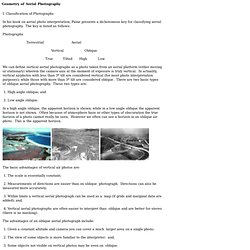

Digital aerial images from kites or balloons. How do I get the camera airborne?

Now that you have your camera ready, you need a way to get it up in the air. There are 4 options I’m going to chat about: hot air balloons, hydrogen balloons, helium balloons and kites. Hot Air Balloons: There are two types of hot air balloons: solar heated and combustion heated. The solar balloons rely on the solar radiation from the sun to heat the air inside the balloon. Believe it or not, they actually work; in fact they can be big enough to lift people ( You need a pretty calm day and bright sun but if you have these conditions it’s a pretty neat trick to get a camera in the air without any additional fuel source.
Hydrogen balloons: (don’t even go down this road). Helium Balloons: Now this is the way to go. Kites: These work great when you have steady wind. Registration of Stereo Pairs and the Stereo Window. In this chapter we outline the theory of registration and the stereo window. This is followed by a discussion of some tools to help get it done efficiently and effectively. The emphasis here is on making prints for viewing, or making stereo pairs for the web. Registration methods for projection are discussed in chapter 7, though the basic theory is discussed below. Before presenting a stereo pair it is necessary to align the images carefully. Film slops around inside film cameras (unless you use a very specialized scientific-grade pin-registered camera). This misalignment of the images can cause severe eye strain and make it difficult to fuse the image pair, no matter what the presentation technique.
Here is a simplified discussion of registration. Fig. 5.1 Image Registration There are three ways to move, or register, the right image (blue) with respect to the left one (red): Horizontal Translation in x. Vertical Shift in y. Twist , or Rotation, in q. 1) Remove any vertical error. Scale and Area Measurement. Numbering, Scale, and Indexing Aerial Photographs. Each aerial photograph contains in its margin important information for the photo user.

The arrangement, type, and amount of this information is standardized; however, the rapid development of cameras, film, and aeronautical technology since World War II has caused numerous changes in the numbering and titling of aerial photographs. As a result, the photo user may find that the marginal information on older photographs varies somewhat from the standard current practice. With certain camera systems, some of the data are automatically recorded on each exposure, while other systems require that all titling data be added to the film after processing. Before a photograph can be used as a map supplement or substitute, it is necessary to know its scale. On a map, the scale is printed as a representative fraction that expresses the ratio of map distance to ground distance, For example: Figure 8-8. Volume 1, Lecture 6. Considering that most aerial photographs are not perfectly vertical, there are three different photo centers: the principal point, the nadir, and the isocenter.

Each one of these centers plays a specific role and is of great importance to the photogrammetrist because different types of distortion and displacement radiate from each of these points. Theoretically, if an aerial photograph is perfectly vertical, the three centers coincide at one point (i.e., the principal point), which is the geometric center of the photograph defined by the intersection of lines drawn between opposite fiducial marks (figure 6.6).
The principal point is the optical or geometric center of the photograph. It is the image of the intersection between the projection of the optical axis (i.e., the perpendicular to the center of the lens) and the ground (figure 6.6). Geometry of Aerial Photography. I.

Classification of Photographs In his book on aerial photo interpretation, Paine presents a dichotomous key for classifying aerial photography. The key is listed as follows: Photographs Terrestrial Aerial Vertical Oblique True Tilted High Low We can define vertical aerial photographs as a photo taken from an aerial platform (either moving or stationary) wherein the camera axis at the moment of exposure is truly vertical.